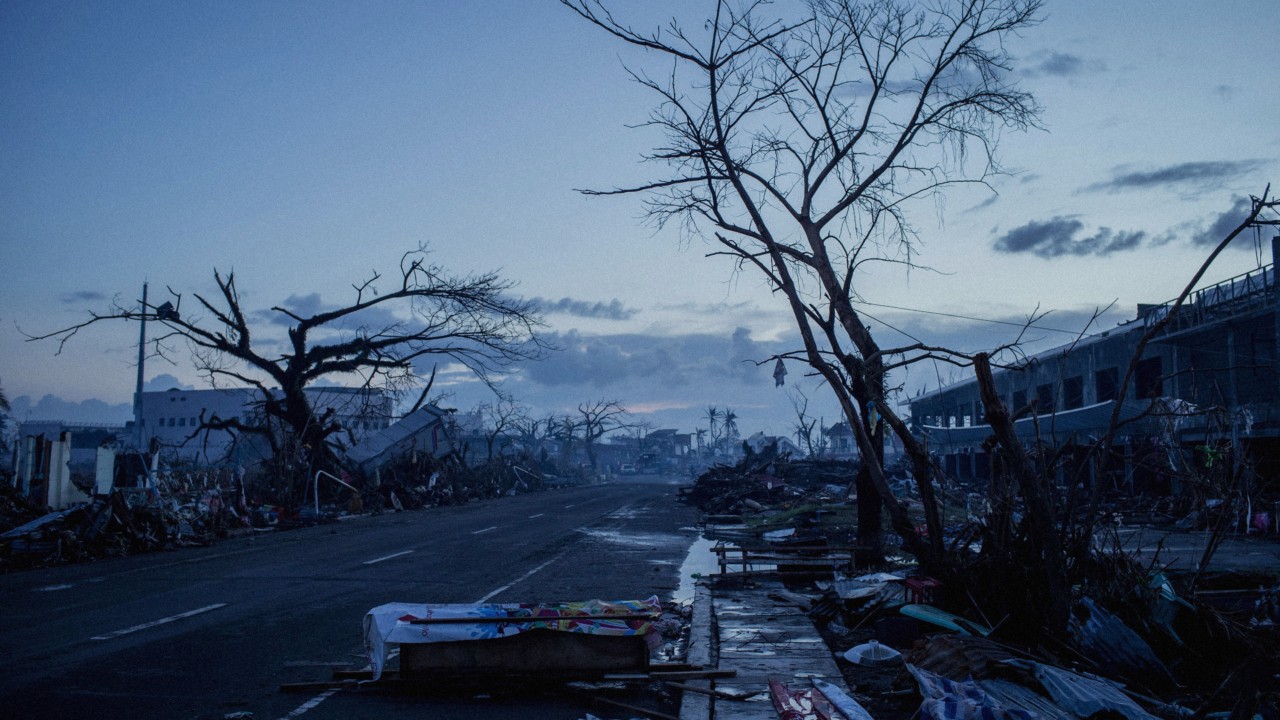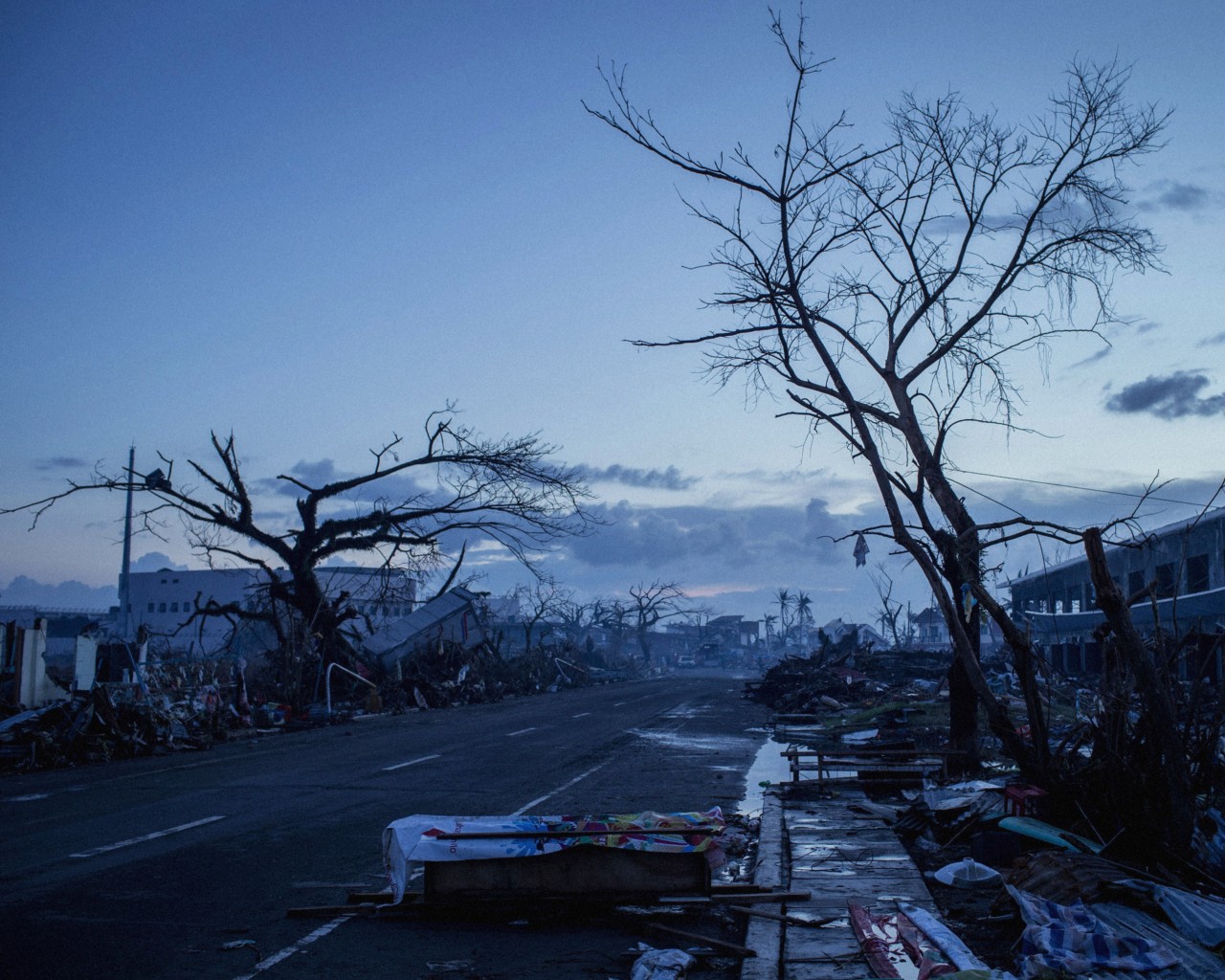

Photograph by Chris McGrath / Getty Images
Words by Nicole Abriam
When Typhoon Haiyan tore through the Philippines in November 2013, it killed more than 6,300 people and left over 4 million homeless. The storm’s devastation lingers more than a decade later. With sustained winds reaching 196 miles per hour, Haiyan remains one of the deadliest storms in history and the costliest the Philippines has ever faced, with damages now exceeding $13 billion.
Haiyan is not an outlier. Other disasters have revealed staggering losses and the limits of recovery for frontline communities. The Great East Japan Earthquake and subsequent tsunami in 2011 cost an estimated $220 billion, making it the most expensive natural disaster in history. Just a few years earlier, Hurricane Katrina inflicted $135 billion in losses across the United States. Over the past two decades alone, climate disasters have caused an estimated $2.8 trillion in damages, according to the World Economic Forum. By mid-century, that figure could climb up to $3.1 trillion per year—losses that many nations in the Global South simply cannot absorb.
The mounting costs reveal a painful truth. Most countries and communities have for too long had no clear legal pathway to demand compensation for the devastation they’ve endured. But a new global framework for climate reparations could change that, giving frontline communities the tools to recover and creating a mechanism to hold the wealthiest, highest-emitting corporations accountable for the damage they cause.
In the Philippines, CLIMA—short for the Climate Accountability Act—is a first-of-its-kind attempt to do what past petitions could not: turn climate justice into law.
That effort traces back to Typhoon Haiyan. In the two years after the storm, several survivors filed a landmark petition to the Commission of Human Rights. The petition accused major carbon-emitting industries, primarily oil, gas, and coal, of human rights violations and demanded they be held accountable for the effects of climate change that affected communities like those in Tacloban, a city in the Philippines where more than 2,300 people were killed during Haiyan.
That complaint culminated in a groundbreaking 2022 report by the Commission of Human Rights, the first in the world to formally establish a link between climate change and human rights violations. “It’s a very compelling report,” Joy Reyes, a lawyer who works with Friends of the Earth Philippines, told Atmos. “One of its salient provisions was that climate justice is a human rights issue, and that corporations can be held liable for human rights violations. Corporations knew about the climate crisis early on, but refused to take measures to mitigate it.”
“In the Philippines, CLIMA—short for the Climate Accountability Act—is a first-of-its-kind attempt to do what past petitions could not: turn climate justice into law.”
But while precedent-setting, the Commission of Human Rights report carried no legal weight. “It is not legally binding because the Commission of Human Rights is not a court,” said Reyes. “And so Greenpeace, Friends of the Earth Philippines, and Natural Resources Center came together and were like, OK, next step is to draft a bill that would put the report’s findings into a legal policy framework.” The following year, on November 22, 2023, House Bill 9609—otherwise known as the CLIMA bill—was introduced in the Philippine Congress.
CLIMA became the first legislation of its kind to set a legal precedent for holding corporations accountable for their role in the climate crisis and to open the door for communities to seek reparations for the loss and damage they have suffered. The bill is rooted in the “polluter pays” principle: the widely accepted idea that those who cause the damage should bear the costs. Though not yet law, advocates say the bill could transform climate justice in one of the world’s most vulnerable nations and perhaps lay the groundwork for similar frameworks elsewhere as climate change makes every country more exposed.
“Statistics show that the top 10% of global economies and corporations are responsible for more than half emissions on the planet,” said Reyes, who helped draft the CLIMA bill. “That’s one of the points we’re trying to make: that corporations have done a lot to change the narrative around the climate crisis, to dispense responsibility and shift accountability away from themselves and into individuals.”
The scale of corporate responsibility is stark.
New research finds that just 122 corporations are responsible for 72% of fossil-fuel-linked carbon emissions from 1854 through 2022, according to the Carbon Majors report published in April 2024. “If we’re able to show the connection between corporations and the environmental degradation and ecological destruction, then perhaps the goal of the bill has been met,” said Reyes. “It’s about creating an accountability mechanism between the effects, the impacts, and also the costs.”
Whether such a mechanism is politically feasible often depends on economics, and the energy market is shifting in ways that could open the door. Renewables are getting cheaper, while fossil fuels lose ground. Coal, one of the largest sources of emissions, is no longer the cheapest source of electricity almost anywhere in the world, noted Gernot Wagner, a climate economist at Columbia and author of Climate Shock. “For the most part, solar power, wind, and increasingly also batteries are cheaper,” he said. “And they can only get cheaper and better still.”
“If we’re able to show the connection between corporations and the environmental degradation and ecological destruction, then perhaps the goal of the bill has been met. It’s about creating an accountability mechanism between the effects, the impacts, and also the costs.”
This market shift could make it easier for governments to embrace accountability. “The way to allow politicians to vote for polluters to pay is by making cleaner alternatives cheaper,” Wagner added. “It’s easier to get a carbon price, a fee for emitting carbon emissions, if you emphasize the need to [lower the cost of] cleaner technology.”
CLIMA builds on the same logic of accountability. At its core is one of its most ambitious provisions: the Climate Change Reparations Fund, a pool of money where victims could file claims and receive compensation for economic losses, relocation, recovery, and even long-term rebuilding. Managed by the Philippine Bureau of Treasury, the fund would launch with about $88,472. It’s a modest start, but one designed to grow.
Globally, similar efforts are taking shape. At COP28 in Dubai, world leaders pledged $661 million to a global loss-and-damage fund under the United Nations Framework Convention on Climate Change. But while the fund’s creation signaled a moment of rare unity, the amount falls painfully short. “The pledge is just 0.1% of what is actually needed by developing countries for their loss and damage needs,” said Reyes. The numbers speak for themselves. The Great East Japan Earthquake and Tsunami, Hurricane Katrina, and Typhoon Haiyan each caused losses in the hundreds of billions. The difference between what’s needed and what’s delivered is staggering.
That gap is precisely what CLIMA is designed to address. By giving climate-vulnerable communities in the Philippines a legal framework to demand just reparations, the bill also offers a model that could be replicated elsewhere. As temperatures rise, as storms intensify, and as communities struggle to rebuild, the need for action has never been more urgent. And while the window for change is closing fast, frameworks like CLIMA show that frontline communities can still turn loss into precedent and precedent into power.
The Legal Fight to Make Corporations Cover Climate Losses